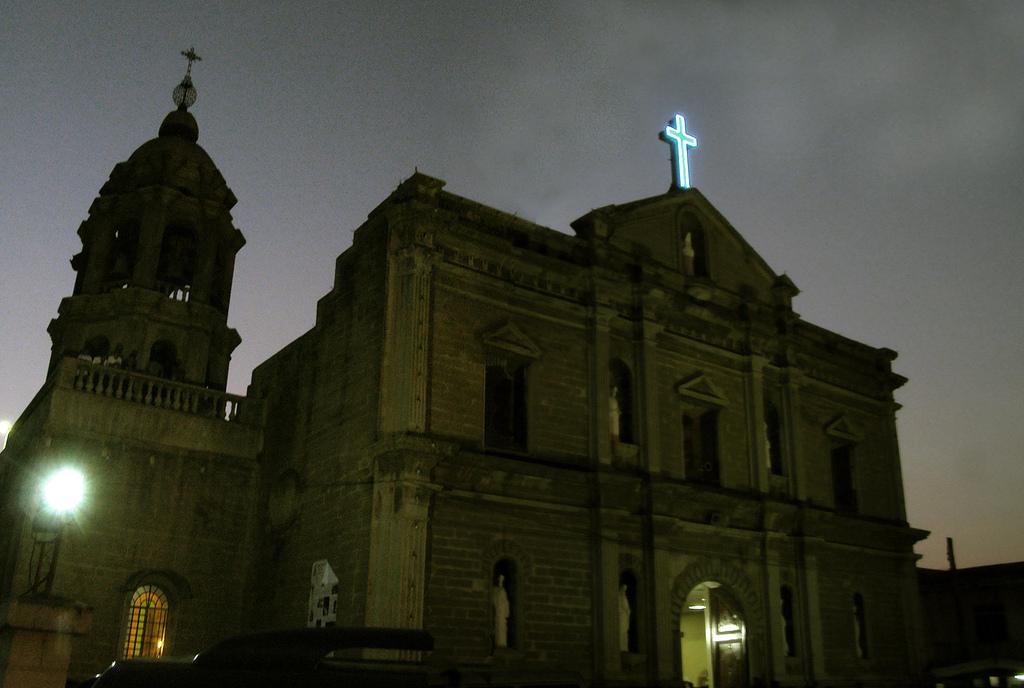
Santa Rosa de Lima Church was built in the year 1792 with the arrival of Padre Francisco Favie. The town of Sta. Rosa used to be a small village in the town of Biñan called "Bukol" because the southern part of this area has many hills. The first house of worship was called "Bisita," and was erected adjacent to the old government building, and known as "Presidencia". This building remains standing next to the Old Government Building and known as Museo de Santa Rosa today.
The church has eight large bells. Its sounds can be heard in nearby districts. Each bell has its own identity according to the names of saints. Santa Rosa De Lima - the largest bell, Santa Barbara, Santissimo Sacramento, San Juan Bautista, San Jose, Santa Cecilia, Santo Domingo.
Each bell is inscribed with the name and place of residence of the priests. There is also a large clock a meter and a half in diameter, sounding every quarter of the clock. It was damaged by fighting planes between the Japanese Air Force and the American forces (USAFFE). It also caused the removal of the statue of the saints that were often used in processions every Lenten season.
On January 18, 1792, the village of Bukol became a town. The name of town is renamed after saint Santa Rosa of Lima, Peru. Several statues of saints were placed on the church threshold in the year 1989-1990 with names - San Lucas, San Mateo, San Juan, Santa Maria, San Jose and Santa Rosa de Lima positioned on top of the other statues.
The various changes and arrangements of the church took place with the help and leadership of some of the priests who served in the church. Father Andres Tejador gave inspiration to a professional painter, Mariano Sr. Perlas, who painted the ceiling of the church and was said to have become main attraction of the church during the years of 1923 to 1960. His paintings can be compared to the beauty of the ceiling of Quiapo Church.
Some of the images painted are the Assumption of the Blessed Virgin, The Coronation, The Four Evangelist, Saint Roche. During the time of service of Father Augustin Reyes, the pictures painted on the ceiling of the church were removed and rearranged because some of the it were broken caused by bats and the age of the paintings themselves.
The two pictures painted on the ceiling near the "koro," the Patron Saints of Christian Music and Holy King David with the harp and Cecilia at the piano, are left on the ceiling of the church. Father Buenaventura Ubarco is the one who introduced PYCL or Parish Youth Council of the Laity with the help of Sister Carmelita C. Decasa. Father Jhon Paul Villanueva assumed the attribution of Adoration Chapel with the use of the baptistery. He also established various organizations in the church.
Father Antonio Atienza is the priest who assumed the renovations of the church including the church entrance and the cemetery inside. He also placed the images of Santa Rosa de Lima, Saint Joseph, The Virgin Mary and the Four Evangelist. Fr. RM. Castillo, with the support of stakeholders, was the one who enhanced the beauty of the church and decided to build a patio and the fourteen Stations of the Cross, altar expansions and configuration of the church entrance.
Santa Rosa de Lima, the town’s patron saint, is believed to be miraculous. During the Japanese occupation, some who fled from nearby villages witnessed a beautiful woman wearing a black and white dress who encouraged them to go to Santa Rosa where rice and fish were plentiful and they will not go hungry. Upon arriving at the church, the townsfolk said that the woman who brought them there was no other that but their patron, Santa Rosa.
Japanese soldiers riding on their horses tried to get inside the church, but they could not enter the church because their horses were going wild and wanted to remain outside.
Accommodations
Here is the list of hotels that can be found in Sta. Rosa City, Laguna that offers good services and accommodations to all visitors.
- Paseo Premiere Hotel - Sta. Rosa Business Park, Santa Rosa, Laguna
- Technopark Hotel - Greenfield Auto Park, Santa Rosa, Laguna
- Amethyst Econotel - Amethyst Road, Sta. Rosa, Santa Rosa, Laguna
- El Cielito Inn - Santa Rosa, Laguna
- Laguna Technopark Hotel - Santa Rosa, Laguna
- Golden Gate Inn - Santa Rosa, Laguna
- Mariposa Star Motel - Santa Rosa, Laguna
- Balibago Drive Inn (also known as Kamachille) - Barangay. Balibago, Sta. Rosa City Laguna
Accessibilty
- Southern route-South Expressway is the main artery , with exits at San Pedro, Binan, Sta Rosa, Cabuyao and Calamba;
- Eastern route-Ortigas Avenue through the towns of Rizal and onward to the eastern towns of Laguna through the Laguna de Bay road network;
- CALABARZON (Cavite-Laguna-Batangas-Rizal-Quezon) route-The highway system and well-developed road network of this region links the neighboring provinces with ease and convenience for tourism, trade and commerce.
- Major bus companies ply the well developed roads to and from Metro Manila and within the CALABARZON on a regular basis. Bus terminals are located at Buendia and Taft Avenue and EDSA in Pasay City.










